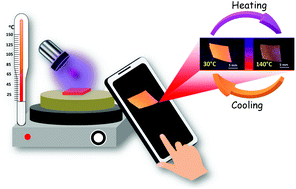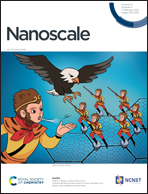Reversible temperature-dependent photoluminescence in semiconductor quantum dots for the development of a smartphone-based optical thermometer†
Abstract
Photoluminescence (PL) intensity-based non-contact optical temperature sensors are in great demand due to their non-contact nature, rapid response, sensitivity, as well as thermal and chemical stability at different environmental conditions. However, herein, reversible temperature dependent PL emission quenching properties of chemically synthesized Mn2+-doped ZnS QDs (MZQDs) have been advantageously utilized for achieving the development of a smartphone-based optical thermometer. The temperature dependent variations of PL have been studied by taking MZQDs in various forms, such as in aqueous dispersion, powder form, and a polymer-encapsulated thin film. The origin of the PL quenching of MZQD in the polymer film has been cross-verified through temperature-dependent electrical conductivity measurement and the movement of charge carriers has also been confirmed by the first-principles DFT simulation. Through thermal cycling experiments on QD-encapsulated polymer film and by utilizing an indigenously-developed Android App based on color coordinates, a novel smartphone-based colorimetric imaging method for the measurement of temperature has been demonstrated in this work. The synthesized smart QDs might be suitable candidates for temperature sensing and the colorimetric thermometer probe may be utilized in various photonics applications as a smart optical sensor for daily life applications.



 Please wait while we load your content...
Please wait while we load your content...